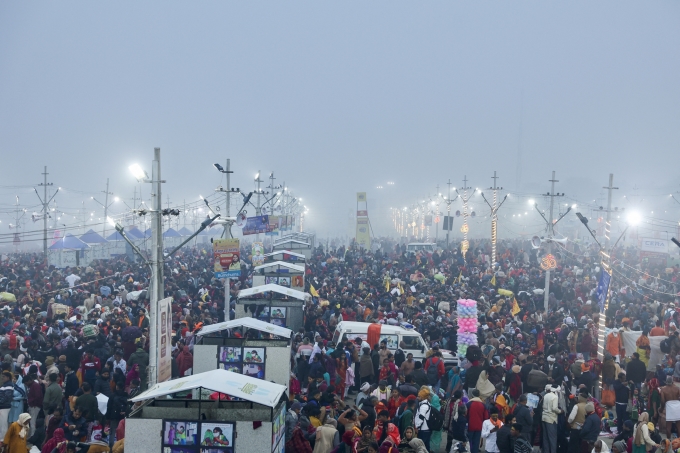
The Kumbh Mela festival is expected to welcome 400 million pilgrims to bathe at the confluence of three rivers in the city of Prayagraj.
Crowds of pilgrims began their ritual bathing before sunrise on January 13 on the banks of the Sangam, considered the confluence of the Ganges, Yamuna and Saraswati, the legendary holy river, in the city of Prayagraj in the northern Indian state of Uttar Pradesh.
“I am very happy, it feels like I am bathing in the nectar of immortality,” said Surmila Devi, a 45-year-old devotee.
Businesswoman Reena Rai’s voice rose with excitement as she spoke of the spirituality that had brought her to the festival, where huge tents were packed with people along the riverbanks.
“As a Hindu, this is an occasion not to be missed,” said the 38-year-old, who had travelled more than 1,000 kilometres from Madhya Pradesh state to attend the festival, which runs from January 13 to February 26.
Saffron-robed monks and ascetics smeared with ash weaved through the crowds, many of whom had walked for weeks to get here.
“The world’s largest cultural and spiritual festival is beginning,” said Hindu cleric and Uttar Pradesh Chief Minister Yogi Adityanath, welcoming devotees to “experience unity in diversity, to meditate and bathe in the holy river where faith and modernity meet”.
Organizers say the number of people expected to attend the Kumbh Mela is equal to the combined populations of the United States and Canada.
“About 350-400 million people are expected to come here, so you can imagine the scale of the preparations,” festival spokesman Vivek Chaturvedi said ahead of the opening ceremony.
Hindu monks carrying the sect’s flag began marching towards the river on the evening of January 12. Tractors carrying life-size statues of Hindu gods followed, flanked by elephants, amid the bustling drumbeats of pilgrims.
It took Jaishree Ben Shahtilal three days to get here. She and her neighbours travelled in a convoy of 11 buses from Gujarat state.
“I believe in the existence of gods,” she said. “I have waited a long time to bathe in the holy river.”
Organizers have set up about 150,000 toilets and a network of kitchens that can serve 50,000 people at a time. About 68,000 LED lights illuminate the festival. The city last hosted 240 million pilgrims in 2019. Police patrolled day and night to ensure security.
The government and police have set up a network of lost-and-found centres and released a mobile app to help pilgrims who get lost find their families. Many pilgrims began bathing in cold water on January 12 despite the rain and the nighttime temperature dropping to 15 degrees Celsius. They said the rain only added to the “religious atmosphere”.
“Once you immerse yourself in the water, you don’t feel cold anymore,” said Chandrakant Nagve Patel, 56. “I feel like I have become one with the divine”.
Hindus believe that bathing during the Kumbh cleanses sins and saves the soul. Bhawani Baneree, a civil servant in the state of Maharashtra, said the “vibrant atmosphere” was worth the long journey.
“Everything is so beautiful,” he said.




